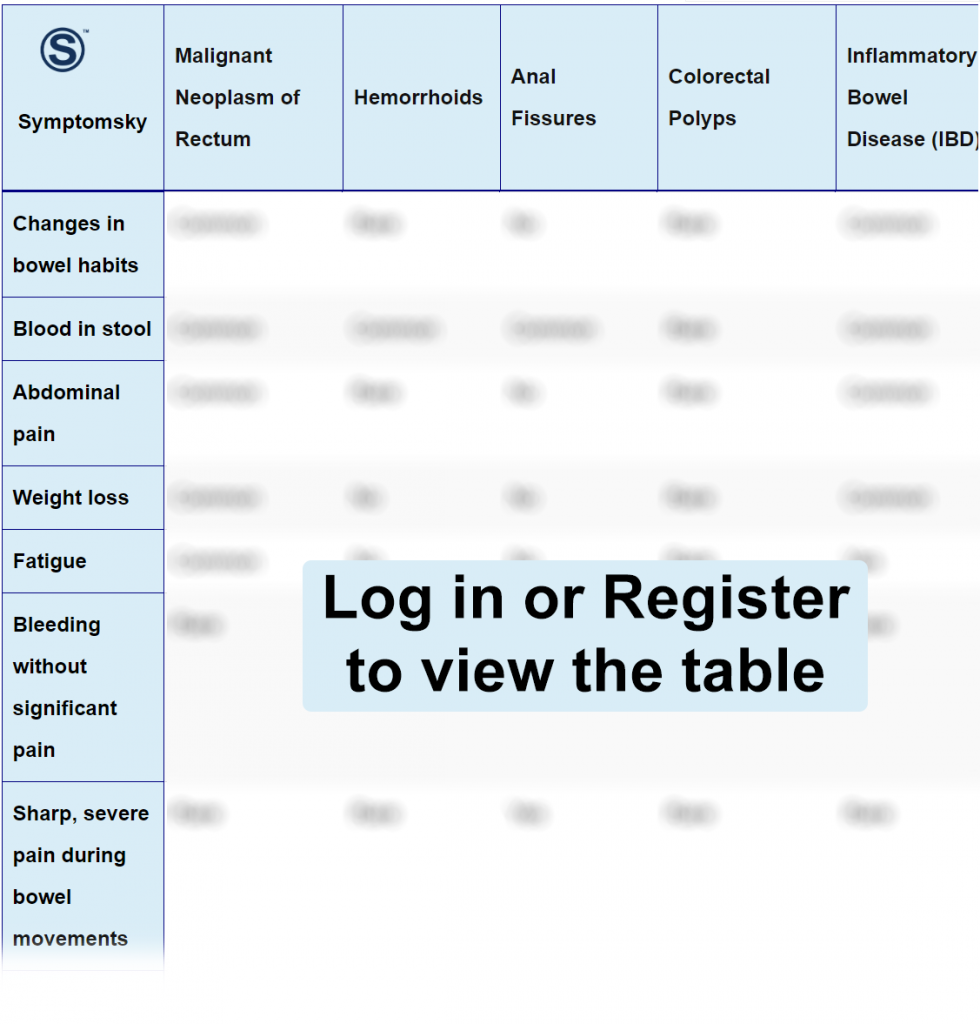Contents
- 1 Malignant Neoplasm of Rectum Differential Diagnosis Table:
- 2 How to Distinguish Malignant Neoplasm of Rectum from Other Diseases
- 2.1 Distinguish Hemorrhoids from Malignant Neoplasm of Rectum from – Diagnosis
- 2.2 Distinguish Anal Fissures from Malignant Neoplasm of Rectum – Diagnosis
- 2.3 Distinguish Colorectal Polyps from Malignant Neoplasm of Rectum – Diagnosis
- 2.4 Distinguish Inflammatory Bowel Disease from Malignant Neoplasm of Rectum – Diagnosis
- 2.5 Distinguish Diverticulitis from Malignant Neoplasm of Rectum – Diagnosis
- 3 Common Red Flags with Malignant Neoplasm of Rectum
Malignant Neoplasm of Rectum Differential Diagnosis Table:

The ingested food passes through the mouth and esophagus to reach the intestine. In between the passing, nutrients are absorbed, and the waste material is transformed into feces and leaves the body passing through the last part of the intestine, which is the rectum, followed by the anus.
Sometimes the normal division of the cells of the rectum disrupts, and it starts to divide more than intended and invade nearby structures. This is known as a malignant neoplasm of the rectum. Among the United States population, it is the third most commonly diagnosed cancer and the most deadly among all.
The common symptoms include pain, change in bowel habits, rectal bleeding, unexplained weight loss, lethargy, change in appetite, and mucous discharge.
How to Distinguish Malignant Neoplasm of Rectum from Other Diseases
Distinguish Hemorrhoids from Malignant Neoplasm of Rectum from – Diagnosis
Hemorrhoids, also known as piles, are the swollen veins at the end of the large intestine, typically in the rectum and anus.
- Rectal cancer usually produces unexplained weight loss, which is a rare finding in hemorrhoids.
- Moreover, hemorrhoids extensively produce pruritis in the anal region, where it is a rare finding in rectal cancer.
“On the physical examination, hemorrhoids are sometimes visible and can be palpated; this is not the case with rectal malignancy. Malignant lesions are usually diagnosed with a biopsy”.
Distinguish Anal Fissures from Malignant Neoplasm of Rectum – Diagnosis
An anal fissure is a tearing of the lining of the large intestine, usually near the anus.
- Abdominal pain is a common finding in rectal malignancy. It is not present in the anal fissure.
- Other than that, fissures are usually tears in the anus, so while passing the stool, a sharp and intense pain commences which can stay for minutes to hours. Pain associated with defecation is uncommon in rectum cancer.
Distinguish Colorectal Polyps from Malignant Neoplasm of Rectum – Diagnosis
Colorectal polyps are small protrusions or lumps developed along the wall of the colon and rectum.
- Colorectal polyps usually are asymptomatic; they are diagnosed on a routine clinical examination. However, rectal malignancy produces symptoms.
- Rectal cancer can cause weight loss, a rare finding with polyp presence.
“They both are differentiated on the basis of biopsy.”
Distinguish Inflammatory Bowel Disease from Malignant Neoplasm of Rectum – Diagnosis
Inflammatory bowel disease is a set of two diseases, namely Crohn’s disease and ulcerative colitis, which produces chronic inflammation of the gastrointestinal tract.
- Excessive mucus in stool is a common finding in inflammatory bowel disease, rarely present in rectal cancer.
- Inflammatory bowel disease patients have complaints of chronic diarrhea, which is uncommon in rectum malignancy patients.
Distinguish Diverticulitis from Malignant Neoplasm of Rectum – Diagnosis
Diverticulas are small pouches that form along the wall of the colon. When it is superimposed by infection, it is called diverticulitis.
- Diverticulitis rarely produces rectal bleeding, while it is very common in rectal malignancy.
- There is no unexplained weight loss associated with diverticulitis, as can be seen in rectal cancer.
“Diverticulitis produces tenderness in the lower left abdomen, which can be felt on palpation. It is uncommon in rectum malignancy.”.
Common Red Flags with Malignant Neoplasm of Rectum
Malignancy associated with any bodily system carries a risk and can be fatal. In the case of the rectum, the survival rate is higher, and if it is diagnosed early, the rate can reach 90%. However, it can cause complications which include bowel obstruction or intestinal blockage, fecal impaction, perforation, bleeding, and unintended weight loss. Signs like abdominal swelling, excessive bleeding, confusion, high fever, loss of appetite, excessive abdominal pain, and vomiting should be checked immediately to rule out sepsis, perforation, or intestinal blockage.
